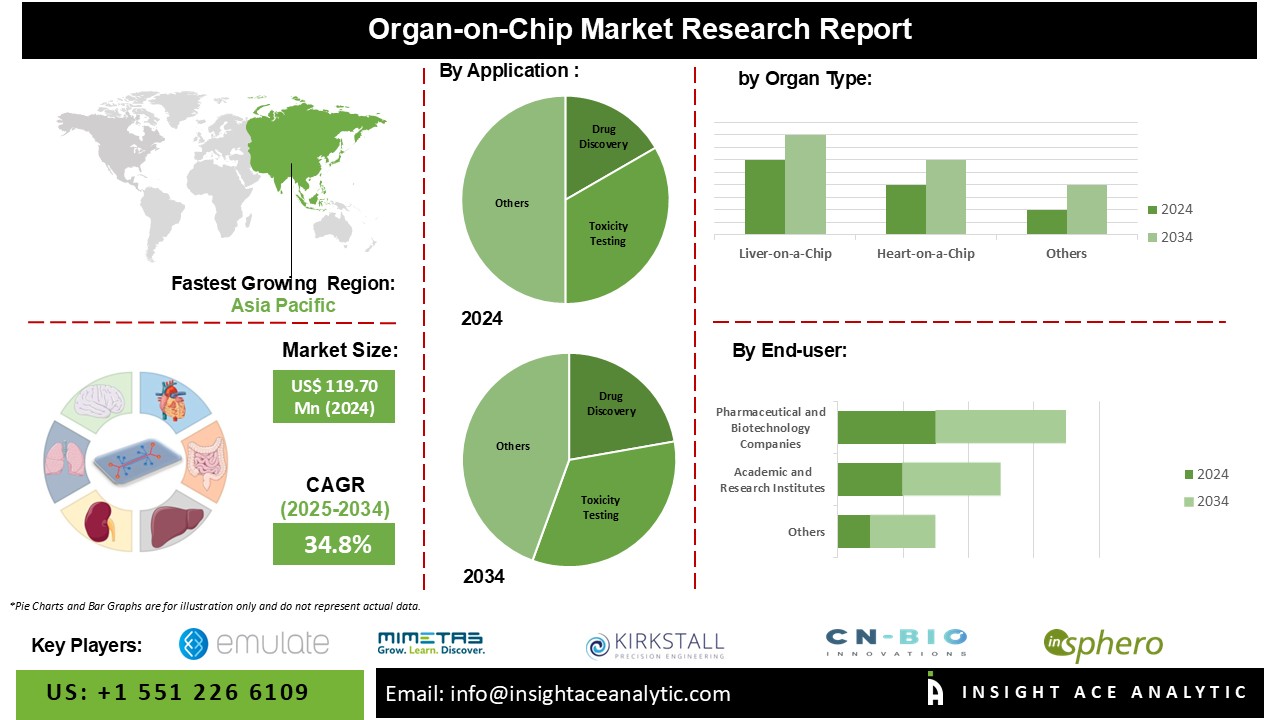Organ-on-Chip Market Size is valued at USD 119.70 Mn in 2024 and is predicted to reach USD 2344.60 Mn by the year 2034 at a 34.8% CAGR during the forecast period for 2025-2034.

Organ-on-a-chip (OoC) technology, which involves micro-engineered biomimetic systems reflecting the structural and functional characteristics of human tissue, integrates biomaterial technology, cell biology, and engineering into a miniaturized platform. Various models have been successfully developed, including lung-on-a-chip, liver-on-a-chip, kidney-on-a-chip, heart-on-a-chip, intestine-on-a-chip, and skin-on-a-chip.
The FDA has expressed confidence in this innovative technology and has formed partnerships with industries and institutes engaged in its advancement. OoC models have broad applications across scientific domains, such as disease model development, drug screening, toxicology, pathogenesis studies, efficacy testing, and virology. The integration of multiple organ-on-chip modules into a unified body-on-chip device holds significant potential for diagnosis and treatment, particularly in addressing complications from the ongoing COVID-19 pandemic. Consequently, the market demand for developing organ-on-chip devices is expected to skyrocket in the near future.
Organ-on-chip (OoC) technology has thrived due to converging advances in tissue engineering and microfabrication. Progress in cell and tissue engineering has evolved from simple 2D monocultures to sophisticated 3D co-culture systems. Another pivotal factor behind the success of OoCs is microsystems technology, a fabrication approach borrowed from the integrated circuit industry. This technology employs lithographic pattern transfer to create nanometer- and micrometer-scale structures. Milestones in OoC development are closely linked with key technological advancements in microsystems technology, which was initially used in analytical chemistry to create laboratory-on-a-chip devices. This technology has propelled the development of microfluidic systems as well as miniaturized actuators and sensors, enhancing the capabilities of OoCs significantly.
The organ-on-a-chip market is segmented by organ type (liver, kidney, intestine, lung, heart, and other organs), model type (organ-based and disease-based models), and product & service offerings, which include instruments, consumables & accessories, software, and both custom and standard services. Applications span toxicology research, drug discovery, physiological model development, tissue regeneration and regenerative medicine, and stem cell research.
Based on purpose, these systems are used for both therapeutic and research needs. Key end users include pharmaceutical and biotechnology companies, the cosmetics industry, academic and research institutes, and other specialized users.
Based on the by application, the market is divided into drug discovery, toxicity testing, and other applications. Among these, the drug discovery segment is expected to be the highest-growing. Pharmaceutical companies are increasingly adopting Organ-on-Chip (OoC) technology for drug discovery to enhance the efficiency and accuracy of preclinical testing. OoCs provide a more reliable prediction of human responses compared to traditional animal models and 2D cell cultures. Additionally, OoC technology supports the development of personalized medicine by enabling the testing of drug responses on chips populated with cells derived from individual patients. This capability is particularly appealing in the context of precision medicine initiatives, as it allows for tailored therapeutic strategies based on individual patient profiles.
Based on the organ type, the market is categorized into liver-on-a-chip, kidney-on-a-chip, lung-on-a-chip, heart-on-a-chip, brain-on-a-chip, and other organ-on-chip. Among these, the liver-on-a-chip segment dominates the market. The liver plays a central role in drug metabolism and detoxification, making liver-on-a-chip devices indispensable for studying drug-induced liver injury (DILI), a major concern in drug development and a leading cause of drug withdrawal from the market. Regulatory agencies, like the FDA, emphasize liver models in their guidance and approvals, further driving the adoption of liver-on-a-chip systems in preclinical testing. Significant research interest and funding are directed towards liver-on-a-chip technology, underscoring its critical role in drug development and disease modeling. This focus on liver models enhances the accuracy of preclinical testing and contributes to safer and more effective drug development.
The Asia Pacific region has witnessed significant expansion in its pharmaceutical and biotechnology sectors, with many global pharmaceutical companies establishing R&D centers to leverage cost advantages and skilled labor. This growth is further fueled by increasing healthcare demands driven by a growing population, the rising prevalence of chronic diseases, and an aging demographic. These factors collectively heighten the need for advanced medical technologies, including organ-on-chip systems, to enhance drug development and healthcare solutions in the region.
| Report Attribute | Specifications |
| Market Size Value In 2024 | USD 119.70 Mn |
| Revenue Forecast In 2034 | USD 2344.60 Mn |
| Growth Rate CAGR | CAGR of 34.8% from 2025 to 2034 |
| Quantitative Units | Representation of revenue in US$ Bn and CAGR from 2025 to 2034 |
| Historic Year | 2021 to 2024 |
| Forecast Year | 2025-2034 |
| Report Coverage | The forecast of revenue, the position of the company, the competitive market structure, growth prospects, and trends |
| Segments Covered | By Model Type, By Organ Type, By Product And Services, By Purpose, By Application, End-User |
| Regional Scope | North America; Europe; Asia Pacific; Latin America; Middle East & Africa |
| Country Scope | U.S.; Canada; U.K.; Germany; China; India; Japan; Brazil; Mexico; The UK; France; Italy; Spain; South Korea; Southeast Asia |
| Competitive Landscape | Emulate, Inc., MIMETAS B.V., TissUse GmbH, CN Bio Innovations Ltd., InSphero, Alveolix AG, Fluigent, Nortis, Inc., Hesperos, Inc., AxoSim, BEOnChip, Altis Biosystems, SynVivo, Inc., Obatala Sciences, Dynamic42 GmbH, Lena Biosciences, AIM Biotech Pte. Ltd., React4life, Initio Cell, NETRI SAS, Revivocell, BI/OND, BiomimX S.r.l., Cherry Biotech, Elvesys, Javelin Biotech, and Kirkstall Ltd. are leading companies operating in the organ-on-a-chip market. |
| Customization Scope | Free customization report with the procurement of the report, Modifications to the regional and segment scope. Particular Geographic competitive landscape. |
| Pricing and Available Payment Methods | Explore pricing alternatives that are customized to your particular study requirements. |
Global Organ-on-Chip Market, By Organ Type
Global Organ-on-Chip Market – By Model Type
Global Organ-on-Chip Market – By Product and Services
Global Organ-on-Chip Market – By Application
Global Organ-on-Chip Market – By Purpose
Global Organ-on-Chip Market – By End User
Global Organ-on-Chip Market – By Region
North America-
Europe-
Asia-Pacific-
Latin America-
Middle East & Africa-